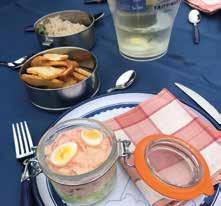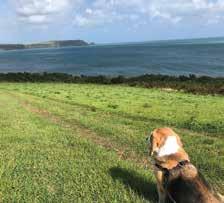
5 minute read
Travel - Cornwall
This is not Hawaii - it’s Cornwall! Carne Beach. (Photo courtesy: S.I. Monshaw)
Cornish Mile By Susan Irving Monshaw
If “as the crow flies” is a way to describe the shortest possible route, a Cornish mile is the exact opposite. In every way, it takes you longer to travel a mile in Cornwall because the actual measure of a Cornish mile equals 1.5 standard miles, and the towering hedges lining the impossibly narrow and winding roads easily double your travel time. While this may be exasperating, the effort in patience and concentration behind the wheel is well worth the effort: Cornwall is simply breathtaking.
As newly arrived American expats, we did not heed the warnings about traffic leaving London on a Friday in the direction of the Cornish coast. Our estimated trip should have been about 5 hours – it took us 7, and that may not include numerous stops to argue about who could better handle the challenge of backing up to let oncoming cars pass by.
Once we crested the hill at Veryan Village and saw Carne Beach below, all of the effort faded away and we were entranced by the magnificent vista before us. Low tide revealed a massive stretch of shore where walkers, dogs, swimmers and kite flyers danced around the gigantic black rocks partially submerged beneath the sand.
The Nare Hotel is set on a bluff with the crashing waves of the English Channel at its feet, rolling green hills blanket the tops of the cliffs on all sides, dotted with cows and old farmhouses. Really, it looks just like a painting. Described as a “country house” hotel, The Nare has been there for 100 years, now just reopening after the recent pandemic. Full English breakfast and a multi-course dinner are included in your room fee, along with the most wonderful afternoon tea. Every day, every single day, I indulged in a slice of Victoria sponge and a cup of Earl Grey – bliss.
We walked the Southwest Coastal Path which runs along the front of the hotel’s property. Don’t the Brits just love walking? The path runs 694 km along the coastline, offering truly breathtaking views of the water and massive rocky sea cliffs along with perfect little villages and delightful historic cottages tucked into the hillside. Of course, we found a tiny pub along the way where we enjoyed a pint and a refreshing bowl of water for our ecstatic beagle, who couldn’t get over his great good fortune at being off leash, rambling for miles.
On our way to the King Harry Ferry, we discovered one of the most exquisite little churches I have ever seen. St. Just, in Roseland, is a 13th century Church of England structure built on the site of a 6th century Celtic chapel. Surrounded by century old, semi-tropical gardens and a uniquely rolling cemetery, St. Just holds a fascinating artifact: a book containing the names and signatures of hundreds of American GIs who were stationed nearby in 1943-44, amassing supplies and gearing up for the D-Day landings just hours away by sea. Clive, the church caretaker and
Perfect picnic aboard the Alice Rose. Cornwall. (Photo courtesy: S.I. Monshaw)

Roseland Heritage Walk, Cornwall. (Photo courtesy S.I. Monshaw)


St. Just in Roseland Church, Cornwall. (Photo courtesy: S.I. Monshaw)
keeper of the splendid gardens, told us that the Americans had engaged local ladies to help with their laundry. As this was a time of extreme deprivation, in addition to payment, the ladies were delighted to discover fresh fruit and chocolate bars in the bottom of those laundry bags, left for them by the thoughtful and grateful soldiers. I stood on a nearby concrete ramp that disappeared into the River Fal and imagined them, those tender young men, preparing for the nightmare they couldn’t possibly conjure.
The sun was retreating from a half-hearted attempt, the wind whipped up and the King Harry Ferry was just arriving, depositing passengers for its last trip of the day. A few boats strained at their moorings and we soon learned that the weather would cancel our plans to cross by ferry, so we drove to St. Ives, a darling fishing village filled with pubs, shops, restaurants and charm. By this time, I wasn’t so intimidated by the narrow roads and enjoyed driving a bit further afield to discover Trelissick House, a 1755 National Trust property featuring an impressive country mansion surrounded by acres and acres of beautiful fields, gardens and a lovely river walk. From here, we discovered St. Mawes Castle where we could look across the river to its twin Pendennis, both built by Henry the Eighth to secure the peninsula from attackers.
The highlight of our visit was a boat tour of the rivers and bays of the Roseland peninsula aboard the Alice Rose. Expertly piloted by Simon, we braved a bit of rain and wind, the only guests on the cruise that day. He is a native of the region, formerly of the Royal Navy, and something of a local historian. Our Captain pointed out yachts owned by famous locals, quiet, lesser-known corners of the inlets, and the best places to swim and fish. While it was too cold to swim that day, we enjoyed a lovely picnic provided by the hotel featuring the perfect prawn cocktail in glass jars, salads and a very respectable white wine.
We stayed a week in Cornwall but wished for another four. There is so much to see, taste, and explore in this stunning part of England. You can save yourself the Friday traffic aggravation by taking the train from London, but you would certainly be cheating yourself of the unforgettable experience of hearing those tiny hedge branches squeak along the side of your car, subtly reminding you that you might be a little too close!











